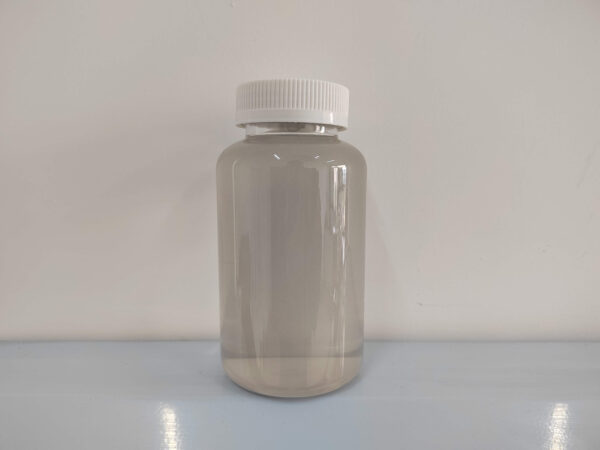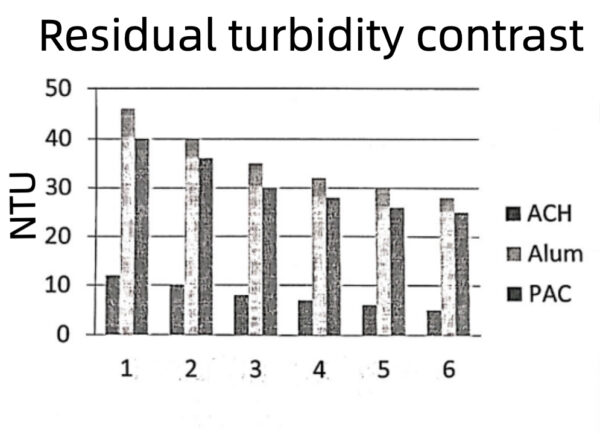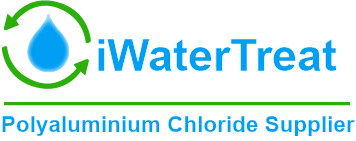
-
Municipal and industrial water treatment: ACH solution is usually applied as the main flocculant in drinking water and industrial wastewater treatment plants, replacing the need for other flocculants such as alum, and in many cases, eliminating or greatly reducing the need for chemicals that adjust pH, such as coagulants and filter aids. ACH is often used in environments where the liquid’s pH is greater than 7.5.
The recognized benefits of switching to ACH solution are:
-
Improved turbidity removal capability
-
Improved color removal capability
-
Enhanced removal of Total Organic Carbon (TOC)
-
Reduced filtration turbidity
-
Improved filtration efficiency
-
Over 50% reduction in sediment
-
Simplified operation, eliminating the need for some pH adjustments and secondary polyelectrolyte additions
-
Reduced overall treatment costs
-
Municipal and industrial wastewater treatment:
-
Total Suspended Solids (TSS) removal
-
Heavy metal removal
-
Phosphorus removal
-
Chemical Oxygen Demand (COD) reduction in industrial wastewater treatment
-
Removal of Biological Oxygen Demand (BOD) and Total Organic Carbon (TOC) in municipal wastewater treatment
-
Pulp and paper manufacturing applications:
-
Sizing adhesives
-
Anionic trash removal agents
-
Retention and filtration aids
-
Resin barrier control additives
-
Neutral sizing precipitants in the paper industry
-
Antiperspirant raw materials:
Advantages of ACH compared to PAC
|
Index Name
|
PAC Index
|
ACH index
|
|||
|
liquid
|
solid
|
liquid
|
solid
|
||
|
Mass fraction of aluminum oxide (Al₂O₃)(w/w)%≥
|
10
|
29
|
23
|
46
|
|
|
Basicity %
|
40-90
|
75-90
|
|||
|
Density (20℃)/(g/cm³) ≥
|
1.12
|
/
|
1.33
|
/
|
|
|
Mass fraction of insoluble substances % ≤
|
0.2
|
0.6
|
0.01
|
0.02
|
|
|
pH value (10g/L aqueous solution)
|
3.5-5.0
|
3.5-5.0
|
|||
|
Mass fraction of arsenic (As)% ≤
|
0.0002
|
0.0001
|
|||
|
Mass fraction of lead (Pb)% ≤
|
0.001
|
0.0005
|
|||
|
Mass fraction of cadmium (Cd)% ≤
|
0.0002
|
0.0001
|
|||
|
Mass fraction of mercury (Hg)% ≤
|
0.00001
|
0.00001
|
|||
|
Mass fraction of hexavalent chromium (Cr6+)% ≤
|
0.0005
|
0.0005
|
|||
|
Mass fraction of iron (Fe)% ≤
|
No requirement
|
0.01
|
0.02
|
||

|
Sample Description
|
Raw
|
1
|
2
|
3
|
4
|
5
|
6
|
7
|
8
|
9
|
10
|
|
Sample Volume(ml)
|
1000
|
1000
|
1000
|
1000
|
1000
|
1000
|
1000
|
1000
|
1000
|
1000
|
|
|
InitialpH
|
4.84
|
4.84
|
4.84
|
4.84
|
4.84
|
4.84
|
4.84
|
4.84
|
4.84
|
4.84
|
|
|
Soda(ppm)
|
8
|
8
|
8
|
8
|
8
|
8
|
|||||
|
Coagulant:
|
|||||||||||
|
Alum.ppm
|
20
|
22
|
24
|
26
|
28
|
30
|
|||||
|
PAC Type3,ppm
|
3
|
6
|
9
|
12
|
|||||||
|
Supernatant Water Quality:
|
|||||||||||
|
Turbidity(NTU)
|
1.97
|
0.51
|
0.51
|
0.29
|
0.26
|
0.28
|
0.32
|
1.22
|
0.89
|
0.21
|
0.81
|
|
Aluminum,Al(mg/L)
|
0.065
|
0.117
|
0.095
|
0.089
|
0.097
|
0.132
|
0.168
|
0
|
0
|
0
|
0
|
|
Iron,Fe(mg/L)
|
0.71
|
.
|
—
|
—
|
.
|
.
|
.
|
0.03
|
0.01
|
0.01
|
0.01
|
|
Manganese,Mn(mg/L)
|
0.021
|
.
|
—
|
—
|
▼
|
▼
|
—
|
0.011
|
0.011
|
0.009
|
0.009
|
|
Description
|
Raw
|
1
|
2
|
3
|
4
|
5
|
6
|
|
Sample Volume(ml)
|
1000
|
1000
|
1000
|
1000
|
1000
|
1000
|
|
|
Pre-Soda,ppm
|
10
|
10
|
10
|
10
|
10
|
10
|
|
|
Coagulant:
|
|||||||
|
ACH.ppm
|
16
|
18
|
20
|
||||
|
PAC,ppm
|
16
|
18
|
20
|
||||
|
Supernatant Water
Quality:
|
|||||||
|
Turbidity(NTU)
|
1.98
|
0.34
|
0.35
|
0.44
|
0.65
|
2.60
|
2.99
|
|
pH
|
4.97
|
6.39
|
6.18
|
6.35
|
5.90
|
6.30
|
5.68
|
|
Colour(Haz)
|
168
|
36
|
27
|
15
|
13
|
33
|
40
|
|
Fc(mg/L)
|
1.39
|
0.27
|
0.30
|
0.15
|
0.23
|
0.62
|
0.68
|
|
Mn(mg/L)
|
0.023
|
0.011
|
0.020
|
0.013
|
0.018
|
0.027
|
0.025
|
|
Al(mg/L)
|
0.140
|
0.036
|
0.074
|
0.033
|
0.068
|
0.139
|
0.162
|
|
NH₃(mg/L)
|
0.07
|
0.04
|
0.05
|
0.04
|
0.03
|
0.04
|
0.04
|
We know that residual aluminum is an important indicator in the effluent of water treatment plants. Aluminum is not easily absorbed and eliminated by the human body and can accumulate, leading to aluminum poisoning. This is one of the important reasons why foreign countries choose to use ACH. ACH can significantly reduce residual aluminum content compared to PAC, effectively improving the water quality of our drinking water.
4. Other Product Advantages:
ACH is not a hazardous material and has no corrosiveness, while PAC has a stronger acidity and some corrosiveness. The product is stable and can be stored for a long time. PAC cannot be left standing for a long time as it will produce a lot of sediment.
In summary, ACH is currently an irreplaceable and absolute advantage product among aluminum salt products, making it the best choice for high-end customers.

Can I simply say what a relief to uncover somebody that truly understands what they are discussing over the internet. You certainly know how to bring an issue to light and make it important. A lot more people must look at this and understand this side of your story. I was surprised that you are not more popular given that you most certainly have the gift.